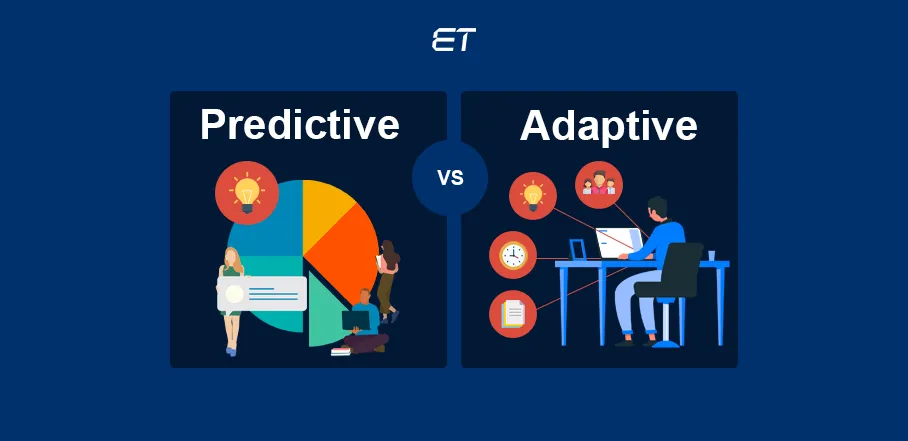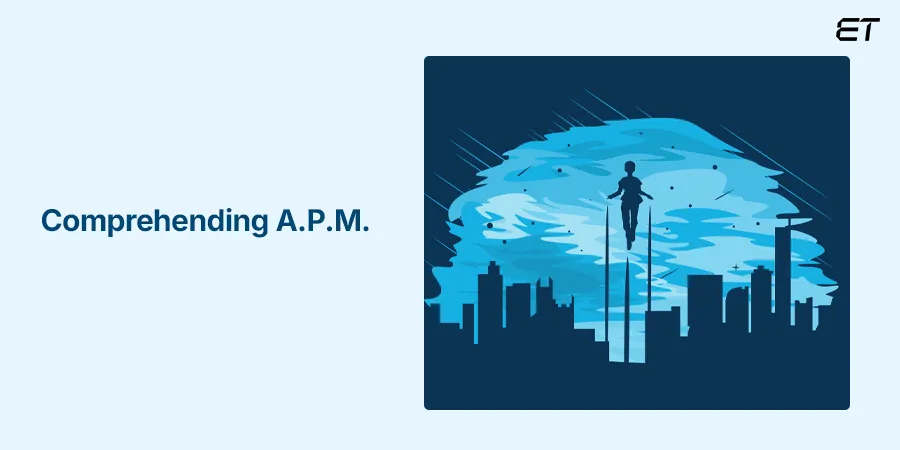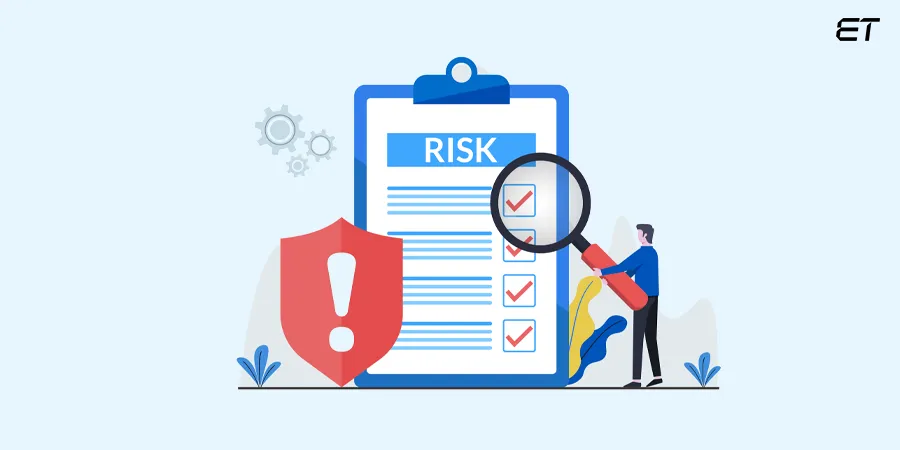
Predictive vs Adaptive Project Management: Taking the Right Call
The Jira board looks chaotic. And the Gantt chart? Sitting idle, unused. If that’s your reality, you need to step back and rethink predictive vs adaptive project management.
It’s no surprise that 70% of projects don’t deliver their business outcomes. The main culprits? Misaligned processes and unclear goals. Both stem from choosing an unsuitable management approach. Unfortunately, that’s where most decision-makers falter.
But YOU don’t need to be that person who costs your company money and morale. How?
The fix is simple. Be immaculate from the start. Between predictive and adaptive management, choose the approach tailor-made for you. And we’re here to simplify the complex, so scroll ahead!
At eLuminous, we have teams well-versed in using both project management approaches.
Predictive Project Management vs Adaptive: TL; DR
If you’re busy and want to skip the details, just know this:
- Predictive Project Management: You plan everything from the start. The project’s goals, timeline, and sequence are crystal clear.
- Adaptive Project Management: There’s a basic plan but you are flexible to adjust it based on new information. The requirements can change at any stage.
Now did you get it?
Predictive vs adaptive project management boils down to the difference between ‘predict’ and ‘adapt.’
- You can use the predictive model in hardware development and regulatory projects.
- The adaptive model is a good fit for marketing campaigns and product innovation.
The following sections explain both the models one by one. So, if you want details, they are the ones to refer to. But before the detailed insights, this table can prove handy:
| Predictive Project Management | Adaptive Project Management |
| Fixed scope and timeline | Flexible scope and evolving timeline |
| Detailed planning upfront | Minimal upfront planning |
| Sequential execution (linear phases) | Iterative execution (sprints or cycles) |
| Minimal stakeholder involvement post-kickoff | Continuous stakeholder feedback |
| Best for certainty and control | Best for uncertainty and innovation |
| Heavy documentation | Lightweight documentation |
| Success = sticking to the original plan | Success = responding effectively to change |
| Tools: Gantt charts, MS Planner | Tools: Jira, Trello, Kanban boards |
Predictive Project Management

Ever seen the movie Titanic?
That’s an excellent example of the predictive management approach. Here’s how:
- The ship’s route and plan were fixed ever since the planned voyage.
- There was a clear goal of sailing across the Atlantic in a set time.
- The crew of the ship relied on the original plan and ignored sudden warnings like the iceberg threat.
- The Titanic didn’t adapt to the sudden iceberg hit (a classic case of most predictive management projects).
The same is true for the predictive approach. You define everything upfront – the scope, cost, schedule, and timeline. What follows is a linear process that has the following phases:
- Initiation
- Planning
- Execution
- Monitoring
- Closure
Overall, the predictive management approach is ideal if your requirements are precise and unlikely to change.
Note: There’s a difference between Waterfall and Predictive management. If you’re interested this Reddit thread is a good one to explore. If you’re short on time, know this: Waterfall is quite rigid while predictive has a critical path that leaves some room to expect a few changes.
Need details on the 7 best project management tools for building your software?
The Benefits of Predictive Project Management
The following table lays down four advantages of the predictive approach that you should know:
| The structure is clear and your team knows the goals and expectations | It is easier to plan budgets and schedules due to high predictability |
| The documentation is thorough and helpful for audits | There is a strong control and governance on the project |
The Limitations of Predictive Project Management
In most predictive vs adaptive project management cases, the former is susceptible to failure. Here are the main reasons why:
| The approach is rigid and doesn’t leave room for adaptation | The stakeholder involvement is minimal |
| Testing phase is towards the end of the project, leading to late detection of issues | Initial planning can slow down the start of your project |
Adaptive Project Management

Want another movie analogy? Think ‘Inception.’
Here’s how Nolan’s masterpiece is an apt example of adaptive project management:
- There’s no blueprint, as Cobb’s team starts with an idea but evolves their strategy later.
- Each dream is like a sprint where the team responds to feedback.
- When the sedative plan backfires, the team adapts, tweaks timelines, and redistributes the roles.
- Everyone on the team contributes ideas and is involved in the execution.
So, we can say that adaptive project management is a change-driven approach. It operates on the principles of continuous learning, iteration, and flexibility.
The main characteristics of the adaptive software development methodology are:
- Iterative execution
- Evolving scope
- Customer collaboration
- Minimal upfront planning
- Team autonomy
All in all, adaptive project management is most effective in fast-paced environments. Additionally, it is an ideal strategy when stakeholder input is frequent.
Note: Agile is not adaptive project management. It is one of the frameworks in this model. Adaptive has a broad scope, but agile is primarily relevant in the software development industry.
Adaptive Project Management Benefits
Here are four solid reasons why over 90% of companies adopt one of the leading frameworks in adaptive:
| You can pivot quickly when priorities change | The stakeholder involvement is continuous and ensures the project meets the user needs |
| The iterative cycle reduces the risk of costly mistakes | Team autonomy and collaboration can boost problem solving abilities |
The Challenges of Adaptive Project Management
Even if adaptive management appears ideal at first, it has some limitations. Here are the main ones to consider:
| The chances of scope creep are always high if you fail to manage strictly | Sometimes, high stakeholder involvement is not feasible |
| Since the upfront planning is minimal, the budget can become unpredictable | Teams need proper training in adaptive frameworks like Agile or Scrum |
If your focus is primarily on developing software fast, read our guide on adaptive software development.
Predictive vs Adaptive Project Management: Key Differences
Mindset. This is the one word that distinguishes adaptive vs predictive project management. There’s no clear winner here. You simply need to assess the factors and determine which option best suits your needs.
1. The Approach

The predictive model thrives on known aspects. You already know the scope, cost, timeline, and expectations of the project beforehand.
On the contrary, the adaptive development model embraces the unknown. The goals can change. Even the scope and features can change midway.
2. Planning Depth

In the predictive project management methodology, detailed upfront planning is necessary. This planning is the foundation of your project.
Adaptive, on the other hand, can work with minimal base. It’s best suited for dynamic environments and eliminates rework.
3. Stakeholder Involvement

After the initial inputs, stakeholders have little to no say in the predictive model. They wait until the final deliverable and trust the process.
In adaptive project management, stakeholder involvement is continuous. They share feedback and changing needs throughout the project. This way, you are always in the loop and can align the project efficiently.
4. Risk Management

Predictive vs adaptive project management is like traditional vs modern. In the former, you need to identify risks initially and assume they will remain consistent.
Whereas adaptive allows more flexibility in treating risks. Your team can catch them at any instant and solve them simultaneously.
Looking for sound risk mitigation strategies? We have the best resource for you.
5. Style of Delivery

The predictive management delivery is like NASA. The plan is solid, and the launch is massive after years of testing, planning, and approvals. (Example: Artemis Program)
On the other hand, SpaceX is an excellent example of the adaptive management style. It’s more about building, launching, failing, learning, and improving. The upgrades are incremental, and the changes are fast. (Example: Falcon 9)
Which Model Should I Choose, When?
Got the gist behind predictive vs adaptive project management? If your project needs are stable, choose a predictive approach. If they are uncertain, go adaptive.
Still, for better clarity, here are some real-world scenarios.
| Scenario | Model | Reason |
| Government-funded Infra Project | Predictive | The scope is fixed and you have less room for changes |
| MVP Development | Adaptive | Goals are evolving and speed matters |
| Internal IT Compliance Audit | Predictive | The regulations are clear and documentation is detailed |
| Digital Marketing Campaign for 6 Months | Adaptive | Iterations are frequent, algorithm changes are sudden, and campaign influences changes |
| Firmware Development for a Medical Device | Predictive | There’s no room for experimentation |
| Customer-facing Mobile App Interface Design | Adaptive | Needs user feedback, testing, and iterative design |
Overall, these predictive vs adaptive project management examples can help you correlate with some of your current projects.
Schedule a quick consultation call if you need tailored assistance in choosing the right project management approach.
Ready to Choose Between Predictive vs Adaptive Management?
Some comparisons are pretty straightforward to comprehend. Predictive vs adaptive project management is one such topic.
When you think of choosing one, always remember Titanic vs Inception or Batman vs Spiderman analogies. Predictive management is based on upfront planning, detailed documentation, and clear expectations. Adaptive management emphasizes flexibility, continuous learning, and regular stakeholder engagement.
Choose predictive if your project is stable and you know there won’t be many changes going ahead. However, if your project is dynamic and requires constant adjustments to features, adaptive is the best option.
So, consider the variables and make the right adaptive vs predictive project management choice.
There’s no dead end here. We are a team proficient in both project management tactics.
Frequently Asked Questions
1. What is the difference between predictive vs adaptive project management models?
Simply put, predictive management relies on solid upfront planning and a fixed set of steps. Adaptive project management builds on change and evolves in response to ongoing feedback.
2. What are the tools in predictive project management?
Gantt charts, MS Project, CPM Tools, and Work Breakdown Structures are the standard arsenal in predictive management.
3. Which frameworks fall under the adaptive management approach?
Agile, Scrum, Lean, Kanban, and Extreme Programming are the prominent frameworks under the adaptive methodology.





